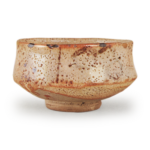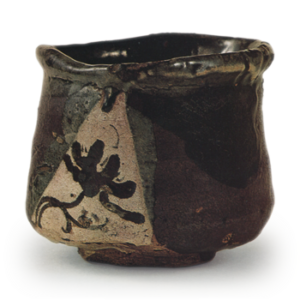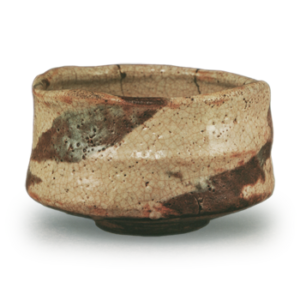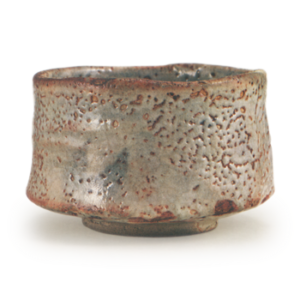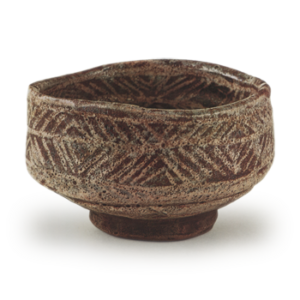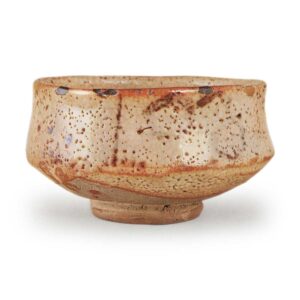
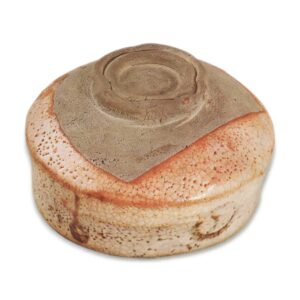
Height: 7.9cm
Diameter: 14.1cm
Outer diameter of foot ring: 6.5cm
Height of foot ring: 1.1cm
The exterior of this tea bowl is strongly raised, and the rim and glaze are a vivid red. The name “Tsūten” is probably taken from the red bridge at Tōfuku-ji temple in Kyoto, which is famous for its autumn leaves.
Like many of the famous Shino tea bowls, this one is thought to have been made in the Momoyama period in the Mino Okaya area, but we can find a common type in the works that have survived. In other words, the rim of this tea bowl is high, the mouth is wide compared to the height of the body, and it seems shallow for a tea bowl, but the body, base, and foot of the bowl also have noticeable traces of scraping, giving the overall impression of a strong and intense work. The waist of this particular tea bowl is particularly low, emphasizing its strength, and it is a work that clearly expresses the characteristics of this type of tea bowl. The irregular shape is also very pronounced, and the preference for deformation is very strongly projected in the molding. The fact that the rim of the double foot ring is pinched in several places to create a flower-shaped foot ring is also thought to be influenced by this.
The feldspar glaze is applied generously and thickly, and the holes are visible all over the surface. Beneath this, the patterns of the tortoiseshell-shaped interlacing, the wood-fiber and bracken interlacing, and the double ring interlacing are faintly visible, and the thick rust-colored painting is a simple decoration that is very suitable for this shape. The lower part of the waist and the fingerprints on the edge of the glaze are also carelessly drawn, and sometimes they even become a good feature of the piece. Speaking of cast pictures, the turtle shell pattern is sometimes seen in other pieces, but the bracken and the double ring pattern are rare motifs in Koshi ware.
As the origin of the name, the fire-colored glaze is particularly vivid around the rim and waist of this teacup, and the beauty of the natural, vivid fire-colored glaze that oozes out onto the surface is one of the great charms that can only be found in Koshi-no ware, and it also has a different flavor to the “Kizen” of the same Momoyama tea pottery, Ko-Bizen.
This color is a hallmark of Koshinowara bowls, and it is fair to say that you will not find this color in any other Koshinowara bowls. Even in the Shino of the Showa period, it seems that the color of the fire was the most painstakingly created, and although many of them seem to have been created using a salt technique to create the color of the fire, the difference between natural and artificial is clearly apparent in the taste.
There are three small marks on the inside, and the foot of the rim is attached in the style of a raised foot ring, forming a so-called double foot ring. There are four repairs on the rim.
Inner box: paulownia wood, plain finish, with a calligraphic inscription on the lid “Tsuutsuu” (unknown author)
Transmitted: Originally from the Hirase family, it was passed on to the current owner after the war.

